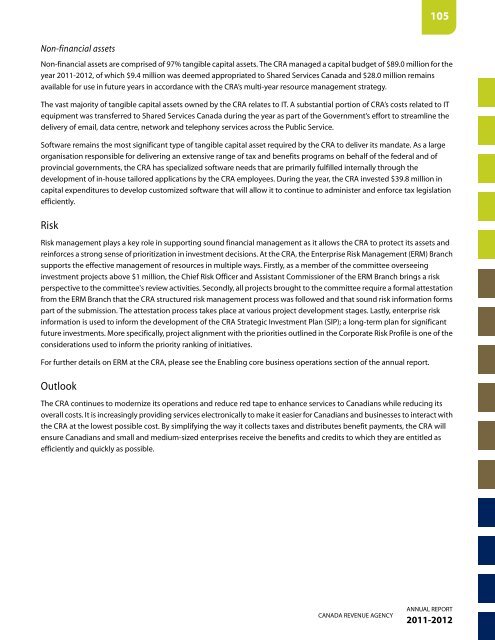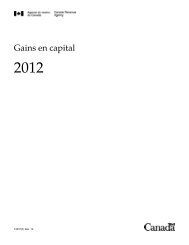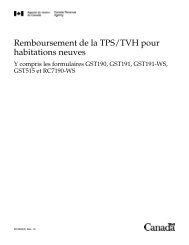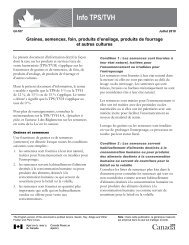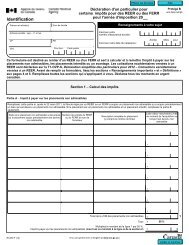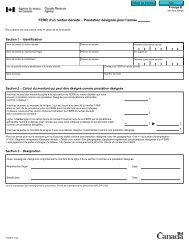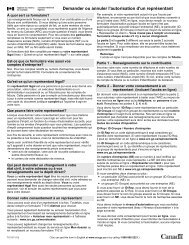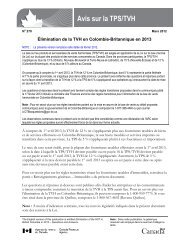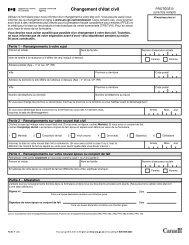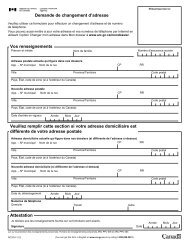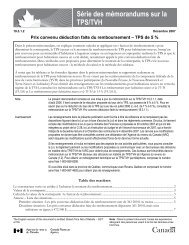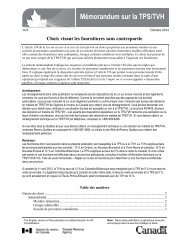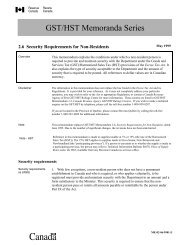CRA Annual Report to Parliament 2011-2012 (PDF - Agence du ...
CRA Annual Report to Parliament 2011-2012 (PDF - Agence du ...
CRA Annual Report to Parliament 2011-2012 (PDF - Agence du ...
Create successful ePaper yourself
Turn your PDF publications into a flip-book with our unique Google optimized e-Paper software.
Non-financial assets<br />
Non-financial assets are comprised of 97% tangible capital assets. The <strong>CRA</strong> managed a capital budget of $89.0 million for the<br />
year <strong>2011</strong>-<strong>2012</strong>, of which $9.4 million was deemed appropriated <strong>to</strong> Shared Services Canada and $28.0 million remains<br />
available for use in future years in accordance with the <strong>CRA</strong>’s multi-year resource management strategy.<br />
The vast majority of tangible capital assets owned by the <strong>CRA</strong> relates <strong>to</strong> IT. A substantial portion of <strong>CRA</strong>’s costs related <strong>to</strong> IT<br />
equipment was transferred <strong>to</strong> Shared Services Canada <strong>du</strong>ring the year as part of the Government’s effort <strong>to</strong> streamline the<br />
delivery of email, data centre, network and telephony services across the Public Service.<br />
Software remains the most significant type of tangible capital asset required by the <strong>CRA</strong> <strong>to</strong> deliver its mandate. As a large<br />
organisation responsible for delivering an extensive range of tax and benefits programs on behalf of the federal and of<br />
provincial governments, the <strong>CRA</strong> has specialized software needs that are primarily fulfilled internally through the<br />
development of in-house tailored applications by the <strong>CRA</strong> employees. During the year, the <strong>CRA</strong> invested $39.8 million in<br />
capital expenditures <strong>to</strong> develop cus<strong>to</strong>mized software that will allow it <strong>to</strong> continue <strong>to</strong> administer and enforce tax legislation<br />
efficiently.<br />
Risk<br />
Risk management plays a key role in supporting sound financial management as it allows the <strong>CRA</strong> <strong>to</strong> protect its assets and<br />
reinforces a strong sense of prioritization in investment decisions. At the <strong>CRA</strong>, the Enterprise Risk Management (ERM) Branch<br />
supports the effective management of resources in multiple ways. Firstly, as a member of the committee overseeing<br />
investment projects above $1 million, the Chief Risk Officer and Assistant Commissioner of the ERM Branch brings a risk<br />
perspective <strong>to</strong> the committee's review activities. Secondly, all projects brought <strong>to</strong> the committee require a formal attestation<br />
from the ERM Branch that the <strong>CRA</strong> structured risk management process was followed and that sound risk information forms<br />
part of the submission. The attestation process takes place at various project development stages. Lastly, enterprise risk<br />
information is used <strong>to</strong> inform the development of the <strong>CRA</strong> Strategic Investment Plan (SIP); a long-term plan for significant<br />
future investments. More specifically, project alignment with the priorities outlined in the Corporate Risk Profile is one of the<br />
considerations used <strong>to</strong> inform the priority ranking of initiatives.<br />
For further details on ERM at the <strong>CRA</strong>, please see the Enabling core business operations section of the annual report.<br />
Outlook<br />
The <strong>CRA</strong> continues <strong>to</strong> modernize its operations and re<strong>du</strong>ce red tape <strong>to</strong> enhance services <strong>to</strong> Canadians while re<strong>du</strong>cing its<br />
overall costs. It is increasingly providing services electronically <strong>to</strong> make it easier for Canadians and businesses <strong>to</strong> interact with<br />
the <strong>CRA</strong> at the lowest possible cost. By simplifying the way it collects taxes and distributes benefit payments, the <strong>CRA</strong> will<br />
ensure Canadians and small and medium-sized enterprises receive the benefits and credits <strong>to</strong> which they are entitled as<br />
efficiently and quickly as possible.<br />
CANADA REVENUE AGENCY<br />
105<br />
ANNUAL REPORT<br />
<strong>2011</strong>-<strong>2012</strong>


